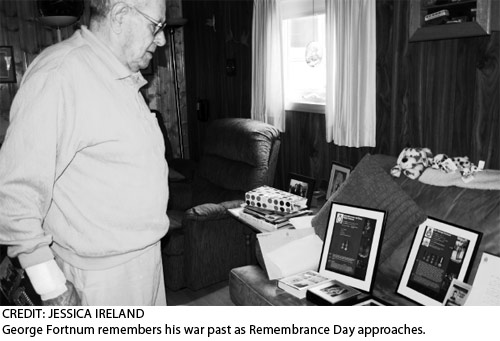A World War II love story

George and Ruby Fortnum's story is like something out of a Nicholas Sparks novel: true love found in a time of battle.
Fortnum joined the Canadian Forces as an engineer in June 1940. He was sent to the base in Petawawa, and returned home for the August long weekend.
After that short break, he went back to Petawawa and in just two weeks was told to pack his gear. He was sent to Halifax with the other soldiers. Fortnum's memory for detail is still keen at his 90 years of age as he recalls approaching the boat to Britain. "There was a huge sign that said, 'Drink Canada Dry,'" he laughed.
Eventually the boat made a northern, and very cold, loop to Scotland, he explained from his home in London. When they reached the shores, they were loaded onto a train and transported to Aldershot.
In Aldershot, they were assigned vehicles to drive soldiers around and Fortnum quickly became known as a man who knew his directions despite the blackout in Britain.
He didn't see much fighting in his time in Scotland, just training and lots of driving. This role as a reliable driver was what led him to meet his future wife.
In 1941, Fortnum spent Christmas with a cousin in Scotland and post-New Year's he returned back to the base. There was a dance planned and one of his friends got Fortnum to drive to pick up a group of girls. Once the two men arrived at the location, Fortnum noticed two girls sitting on a bench having a drink.
It wasn't until after the dance that he'd actually talk to Ruby. When the dance was done, one of the girls said she had to hide from a guy, so Fortnum said that she and her friend could hide in his vehicle. The girls jumped in and Fortnum drove them home. "They happened to be the ones who lived farthest away," he joked. But that drive and drop-off began the "courting of my wife, Ruby," he said with a smile.
Things in wartime were getting "fairly easy" as the Germans ventured into Russia rather than England. So he and Ruby, thanks to his easy access to a vehicle, were able to get to know one another. They often went to see the "pictures," he said.
Then at the end of March, 1942, Fortnum's daily life changed.
"One of the fellas, he asked if I'd take his place to do training," said Fortnum.
Later that year, Fortnum was called up to go to Dieppe, France. So before he made his way to the tanker, he took his Jeep to see Ruby before he left. She said goodbye, in case they never saw each other again. But Fortnum didn't believe that.
"It never entered my head that I'd be killed or I'd be a prisoner," he said. "I had that gut feeling."
It was a feeling that proved to be wrong.
When they arrived in France, the boat still in the water, "all hell broke loose," he said. "When I landed, I couldn't go anyplace � If you moved you were shot at. (The Germans) could see you on the beach."
Fortnum was part of a group who got captured, staying in Germany before being shipped to a prisoner camp in Poland, where there was very little food and they were handcuffed 13 hours a day. Eventually, they were moved to one close to the Baltic Sea. Fortnum went from a muscular 200 pound man to weighing about 132 pounds, he said.
Eventually he and some other prisoners escaped.
All this time, his communication to Ruby was a small prison-issued piece of paper that he had a prisonmate draw a Christmas greeting on. Fortnum still has that card, framed, dated 1944.
When the war was over, he went to a hospital for check-ups to find out he had to be moved to another hospital as he had contracted tuberculosis.
The first person to wake him up? Ruby. "It was the first time seeing her in three years," he said.
He and Ruby had a modest postwar ceremony, and she followed him to Canada. Fortnum took up a career in water conditioning and he and Ruby had three boys.
Ruby passed away in 2008, but Fortnum's love for his wife is still very much alive — as he showed off a picture of her in her British air force uniform, he began crying.
"I loved her, that's all there is to it."













